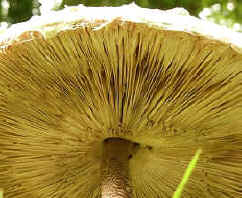| Gill Fungi |
|
|
This type of
fungus includes our familiar edible mushroom. Most, but not all gill fungi, have a stem
bearing a cap on top. The gills, or lamellae as they are also known, are on the underside
of the cap. The spores line the surface of the gills. A single fruiting body may produce
as many as 10,000 million spores! The thickness of the gills, the way they are attached to the stem, and their spacing are all important ways of separating different species. There are in excess of 1,200 different species of gill fungi in Britain. |
|
|
Boletes |
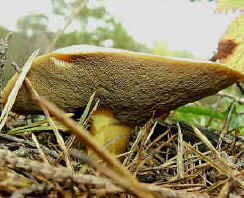 |
These are
fungi which have fruiting bodies similar to many of the gill mushrooms, in that they have
a cap and a stem. However, boletes do not have gills on the undersurface of the cap.
Instead, they have thousands of tiny tubes arranged perpendicular to the surface of the
cap. The underside of the cap thus looks as if it is covered with thousands of little
holes, or pores. Each hole is the end of one of the tiny cylinders, which is lined with
spores. The fruiting bodies of some boletes in Britain reach sizes of 12" in
diameter. Some tropical boletes may exceed 2 feet. The size and arrangement of the pores help to identify different kinds of boletes. There are approximately 60 different species in Britain, almost all of them growing on the ground in association with trees. |
|
Polypores
|
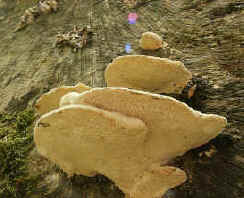 |
Polypores tend to
have very tough, leathery or woody fruiting bodies. They are often plate-like and most
grow out of tree trunks or rotting wood, although some may grow on soil. Some of
these fungi are known as Bracket Fungi, because they look like shelves
growing out of the sides of trees. The pores are located on the underside of the fruiting body and as with the boletes, are lined with spores. Some of these fungi produce a new fruiting body every year, while others produce one which continues to grow year after year. These may reach a considerable size. They may also have visible rings on them which can be counted in a similar way to growth rings in wood. There are more than 40 different species in Britain. |
|
|
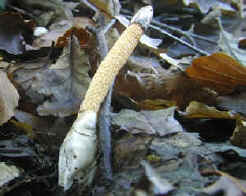 |
Stinkhorns are
truly extraordinary fungi which grow out of a structure which resembles an egg. The fruiting body consists of a bell-shaped head mounted on a stalk. The head is covered in foul-smelling slime, which contains the spores. The smell attracts flies which crawl around in the slime, becoming covered in spores. The flies disperse the spores when they leave and go elsewhere. Two common species. |
|
Earthballs/ Puffballs and Earth Stars |
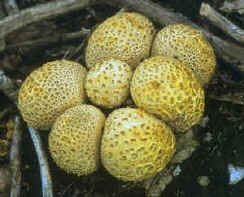 |
These fungi contain their
spores inside a ball of some kind. The ball may be stalked or at ground level. The spore
mass in the centre of the ball is solid to begin with, but later develops into a powdery
mass of spores. In Earth Stars the ball has a tough outer covering which splits and spread out like petals to form a star-shape, exposing the inner spore-containing ball. The outer covering in Earth Balls just disintegrates with time to expose the inner spore mass, while in Puff Balls, the spores are released through a small pore at the top of the ball. There are around 30 species in Britain. |
|
|
 |
This category includes a wide variety of fungi which produce fruiting bodies looking like shapeless blobs of jelly, or in shapes such as 'ears' and 'tongues'. They are soft, or jelly-like and can be found on trees, or on the ground. There are approximately 10 species in Britain. |
|
|
Cup Fungi |
 |
The cup fungi
belong to an entirely different group of fungi to all of those described above. The
scientific name for this group is 'Ascomycetes'.
All of the fungi above belong to a group called 'Basidiomycetes'.
The chief difference between these two major groups is in the method of producing spores.
The Ascomycetes is a large group of fungi. They are the 'spore shooters'. There are many different kinds of Ascomycetes. Some produce a cup-shaped fruiting body, which has the spore-bearing surface on the top, rather than underneath, as in the Basidiomycetes. Most Ascomycetes are microfungi, but there are about 80 species with fruiting bodies of significant size which can be found in Britain. |
